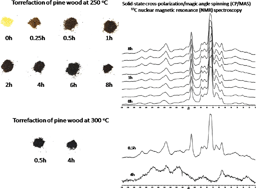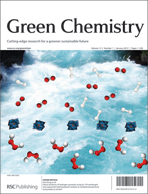The torrefaction of Loblolly pine (Pinus taeda) was examined at 250 and 300 °C, to determine the effects of treatment temperatures on the chemical structure of the torrefied Loblolly pine. Solid-state cross-polarization/magic angle spinning (CP/MAS) 13C nuclear magnetic resonance (NMR) spectroscopy was used to characterize the torrefied and native Loblolly pine. The NMR results indicate that aryl-ether bonds in lignin were cleaved during the torrefaction. The methyl carbons in hemicellulose acetyl groups were no longer present after the torrefaction at 250 °C for 4 h, which is consistent with HPLC carbohydrate analysis of the torrefied wood which indicated that the hemicellulose fraction of pine was completely absent, whereas the cellulose and lignin remained largely intact. Under these conditions the torrefied wood has a relatively high energy yield of 81.29% and a HHV of 24.06 MJ kg−1. After torrefaction at 300 °C for 4 h, the cellulose and hemicellulose in the wood were completely eliminated, the residue contains enriched amounts of carbonyl groups, aromatic carbons and methoxyl groups, which represent complex condensed aromatics, these aromatics units were linked with aliphatic C–O and C–C bonds and the product has a very high HHV of 32.34 MJ kg−1.

You have access to this article
 Please wait while we load your content...
Something went wrong. Try again?
Please wait while we load your content...
Something went wrong. Try again?


 Please wait while we load your content...
Please wait while we load your content...